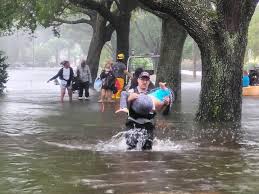
Florida, often referred to as the “Sunshine State,” faces a persistent and significant challenge: hurricanes and the severe flooding they bring. Every year, these powerful storms wreak havoc on the state, leaving behind a trail of destruction, economic losses, and displaced communities. This article delves into the causes, impacts, and measures taken to address the issue of hurricane-induced flooding in Florida.
Hurricane Season in Florida
Florida’s hurricane season spans from June 1 to November 30, a period when the state is particularly vulnerable to tropical storms and hurricanes. Given its geographical location and proximity to warm waters, Florida is frequently in the path of hurricanes that form in the Atlantic Ocean and Gulf of Mexico. These storms, accompanied by high winds, storm surges, and heavy rainfall, often lead to catastrophic flooding.
Understanding Hurricane Flooding
Hurricane flooding is primarily caused by two main factors: storm surges and torrential rainfall. Storm surges occur when hurricanes push seawater onto land, raising water levels and causing coastal flooding. The strong winds generated by hurricanes push this water ashore, leading to inundation of coastal areas. Additionally, heavy rainfall from hurricanes can overwhelm drainage systems and rivers, causing inland flooding, even in areas that are not directly hit by the hurricane.
The Impact on Florida’s Communities
Hurricane flooding has far-reaching consequences for Florida’s communities. Homes are destroyed, infrastructure is damaged, and many people are displaced. The cost of recovery is immense, with billions spent each year on rebuilding efforts. Beyond the economic toll, the emotional and psychological impact on families and individuals is substantial. Communities are often left to cope with the loss of property, livelihood, and sometimes lives.
Florida’s Vulnerable Regions
While all of Florida is susceptible to hurricane flooding, certain regions are particularly vulnerable. The low-lying areas along the Gulf Coast and the Atlantic Coast, including cities like Miami, Tampa, and Jacksonville, face the highest risks. These areas are prone to storm surges and are also susceptible to flash floods due to their proximity to water bodies and low elevation. Coastal developments and the state’s growing population have further intensified the risks.
Environmental and Ecological Impacts
Flooding from hurricanes not only affects human settlements but also has a significant impact on the environment. Wetlands, which act as natural buffers against storm surges, can be degraded or destroyed by floodwaters. Flooding can also lead to water contamination, as sewage systems overflow and pollutants are washed into rivers and oceans. This not only threatens wildlife but also affects Florida’s fishing and tourism industries.
Economic Consequences of Hurricane Flooding
The economic damage caused by hurricanes in Florida is staggering. The cost of rebuilding homes, businesses, and infrastructure can run into billions of dollars. Insurance companies also face heavy losses, which in turn increases insurance premiums for homeowners. Additionally, frequent flooding events disrupt industries such as agriculture, tourism, and real estate, further straining Florida’s economy.
Government and Community Response
In response to the increasing frequency and severity of hurricane flooding, Florida’s government and local communities have taken significant measures to mitigate the impact. Federal agencies like FEMA provide disaster relief and help with long-term recovery efforts. At the state and local level, officials work on improving flood defenses, updating building codes, and investing in flood mitigation infrastructure such as seawalls, levees, and improved drainage systems.
Climate Change and Future Risks
The increasing intensity and frequency of hurricanes have been linked to climate change. Rising sea levels and warmer ocean temperatures create conditions that can intensify storms, making future hurricane seasons even more dangerous. As Florida continues to develop its coastline and attract more residents, the risks associated with hurricane flooding are likely to grow, posing a greater threat to the state’s infrastructure and population.
Flood Mitigation Strategies
In an effort to reduce the damage caused by flooding, Florida has adopted a range of mitigation strategies. These include improving stormwater management systems, restoring natural wetlands, and creating more resilient buildings that can withstand floodwaters. Additionally, some communities are considering retreating from the most flood-prone areas and relocating to higher ground, though this is a contentious and expensive option.
Preparing for the Future
Florida’s battle with hurricane flooding is far from over. As climate change continues to exacerbate the threat, it is crucial that the state and its residents continue to invest in preparedness, resilience, and adaptation strategies. While the risks are daunting, proactive planning and coordinated responses can help mitigate the damage and protect Florida’s communities in the future.Flooding caused by hurricanes is a reality that Floridians must face each year, but with the right strategies and resources, they can be better equipped to withstand and recover from these devastating events.
Subscribe to Follow Global Trends for daily global news.
Find Out How To Make Money As A Full Time Writer/Blogger Guide.
To Advertise, Advertise Your Affiliate Links on FollowGlobalTrends.com for Just $1 Per Link Per Month!
Related Articles
Written By: Enyoghasi Ngozi pricillia

